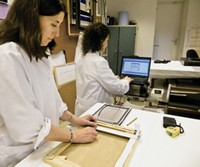Advertisement
Grab your lab coat. Let's get started
Welcome!
Welcome!
Create an account below to get 6 C&EN articles per month, receive newsletters and more - all free.
It seems this is your first time logging in online. Please enter the following information to continue.
As an ACS member you automatically get access to this site. All we need is few more details to create your reading experience.
Not you? Sign in with a different account.
Not you? Sign in with a different account.
ERROR 1
ERROR 1
ERROR 2
ERROR 2
ERROR 2
ERROR 2
ERROR 2
Password and Confirm password must match.
If you have an ACS member number, please enter it here so we can link this account to your membership. (optional)
ERROR 2
ACS values your privacy. By submitting your information, you are gaining access to C&EN and subscribing to our weekly newsletter. We use the information you provide to make your reading experience better, and we will never sell your data to third party members.
Business
Blue Whodunit
Artifact-staining dye structures revealed, but case far from closed
by Carmen Drahl
April 4, 2011
| A version of this story appeared in
Volume 89, Issue 14

This winter, Gilberto Artioli’s team reported the structures of three new pigment molecules. Because the molecules came from samples that originated near Verona, Italy, the University of Padua geoarchaeologist named two of the brilliant blue dyes after Verona’s Shakespearean star-crossed lovers, Romeo and Juliet. Artioli’s dyes are also the protagonists of a drama of their own. And for some researchers, things might have been better if the pigments had never existed.

Artioli’s samples came from prehistoric flint tools that last year began showing very visible signs of contamination—a bright blue tinge. The mystery sparked a furor in Italy and in the archaeology community (Nature, DOI: 10.1038/466306a; ScienceInsider, July 22, 2010). In ensuing media coverage, the case became as much about finding human culprits for the damage as about finding chemical ones.
“Flint stones are commonly rather unreactive materials,” so the blue cast was especially puzzling, Artioli says. With blue-stained flint samples supplied by Laura Longo, then-curator of Verona’s Natural History Museum, and by the regional office of Italy’s Ministry of Culture, Artioli, analytical chemist Andrea Tapparo, and colleagues set to work. Their earliest tests detected contamination with hydrocarbons but didn’t turn up any colored molecules.
Because surface analysis wasn’t yielding any clues, the team decided to look a little deeper. They used warm acetone to extract the blue compounds from a flint sample. High-performance liquid chromatography purification and structural identification nabbed the three pigment perpetrators—Romeo blue, Juliet blue, and flint blue (Anal. Bioanal. Chem., DOI: 10.1007/s00216-010-4625-4). The trio belongs to the triphenylmethane dye family, an old class of synthetic colorants that counts the pH indicator bromocresol green among its members.
Along with the structure identification, the Padua team’s work provides a possible explanation for the blue sheen, which cropped up after the ancient artifacts were moved in 2007 and 2008 to a former military armory when their original home—an 18th-century castle used as a storage site for the museum—was sold to raise funds.
They say that an additive from synthetic rubber mats in the armory storage cabinets is the source. That additive, the antioxidant 2,2,4-trimethyl-1,2-dihydroquinoline, somehow desorbed from the mats to the tools and trimerized to form the blue contaminants. It’s not yet clear how that happened, Artioli says. The flint’s silica surface could be involved, but his team thinks it’s more likely that iron species from inclusions in the flint catalyzed the reaction because the intensity of the blue discoloration lines up with the inclusions in microscope images.
“I’ve been active in [conservation] for 15 years, and it’s the first time I’ve seen something like this,” says Francesca Casadio, a senior conservation scientist at the Art Institute of Chicago. Artioli’s team “does a very good job in characterizing the dyes and proposing what the precursor may be,” she adds. Museum conservation experts typically envision detrimental effects of packing and storage materials in terms of corrosion, discoloration, or formation of white or colorless deposits, not unusually vivid colors as in this case, she explains. Furthermore, “we would be more concerned with metallic, plastic, or wooden objects than with stone,” she adds.
The stone tools remain in the armory, but the regional office of the Ministry of Culture has asked museum officials to remove the rubber mats on the basis of Artioli’s recommendation, says Vincenzo Tiné, the regional supervisor of the ministry. Tests are ongoing to confirm Artioli’s work and to determine whether bacteria from the flint’s surface contributed to the blue dye formation, he adds.
To Longo, who now works for the Culture Department in the municipality of Florence after resigning from her position with the Verona museum in December 2010, those actions come as too little, too late. She says Italian law requires rigorous environmental testing prior to moving artifacts, and testing should have been done when relocating these to the former military armory, which was not explicitly designed for sensitive specimens.
Longo was on leave from the museum from 2005 to 2009 and was not involved with the move. She was suspended without salary from her curator post in July 2010 after complaining that the tools hadn’t been properly transferred. “We have very strict laws for cultural heritage in Italy,” Longo says. “We know exactly what we have to do when we move collections or when we lend archaeological material for exhibitions. So you cannot say ‘Oh, I forgot’ or ‘I didn’t know.’ ”
Longo notes that Neanderthal bones in the same collection as the stained tools were once used in studies of Neanderthal DNA (Science, DOI: 10.1126/science.1147417). To the best of her knowledge, the bones and other items in the collection didn’t turn blue, but that doesn’t mean they weren’t chemically contaminated and their scientific value compromised as well, she says. “Can we rely on the results from any new studies on these materials?”
Artioli’s team is still trying to determine whether the blue discoloration can be reversed. And Tiné says that tests from Verona’s regional occupational safety and health administration have ruled out the possibility of environmental pollution in the armory. “Nobody could foresee that stone materials that have crossed entire eras would have suffered from contact with the soft materials accommodating them,” Tiné says. The tale “teaches us how little we yet know about the complex interactions between storage environment and archaeological items.”
Museums can’t always predict the effects that a change will have on their exhibits because they deal with a wide array of materials, Casadio says. In the art field, it’s common in the U.S. and the U.K. for museum scientists to test new materials, from gaskets to packing crates, which are to be put in contact with collections. The typical procedure, called an Oddy test, places the material to be tested in a warm, humid environment with metal strips as indicators. These conditions accelerate corrosion or other damage that the material or any compounds it emits might cause, she explains. “It’s a pretty low-tech method,” and researchers are seeking better alternatives, she says. “But it’s a first line of defense.”
The case of the blue flint is still far from closed. The Italian press reports that on March 7, two senators in Italy’s Parliament introduced a petition to Sandro Bondi, Italy’s minister of culture, demanding that the prehistoric collection be transferred out of the armory to a safer place and that parties responsible for damaging the artifacts be identified. Last summer, eminent archaeologists and paleoanthropologists signed a similar petition. And Verona’s chief public prosecutor is reviewing evidence to determine whether crimes have been committed under Italy’s cultural heritage laws.
The story “makes a strong argument for fostering interdisciplinary research that can bring a more scientific grounding to storing works of art,” Casadio says. “We’ll still have unexpected events, but we can try to develop more preventive conservation measures.”
“Care and precaution in conservation are never excessive,” Artioli adds.






Join the conversation
Contact the reporter
Submit a Letter to the Editor for publication
Engage with us on Twitter